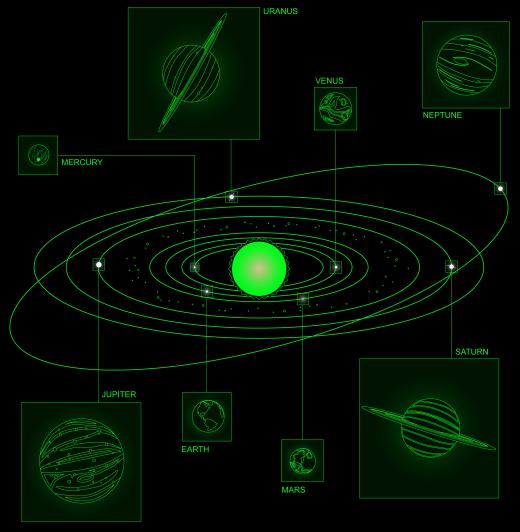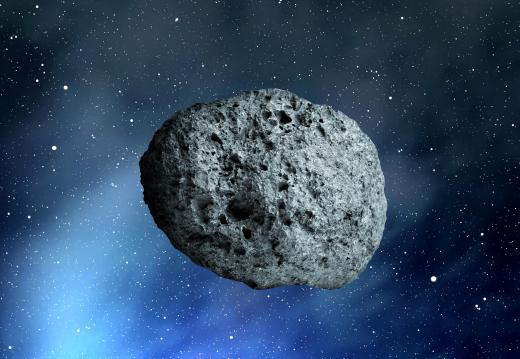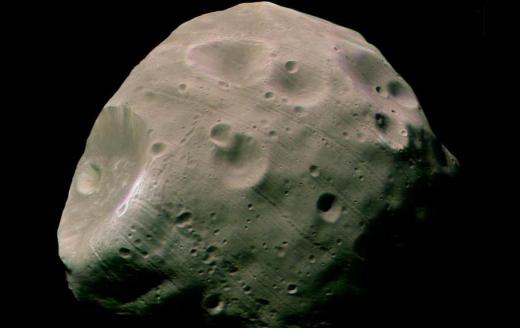What is an Asteroid?
 Mary McMahon
Mary McMahon
An asteroid, sometimes called a planetoid, is a small celestial body which orbits around the sun, along with other objects in the solar system such as planets. However, unlike the planets, asteroids are typically very small, with only a handful of asteroids reaching immense sizes. The largest known asteroid is Ceres, which is 580 miles (930 kilometers) in diameter. After the discovery of Ceres in 1801, many other asteroids were discovered, since astronomers knew what to look for. Thousands of new asteroids are discovered every year.
The name asteroid comes from the Greek asteroides, which means “star like.” Asteroids are irregularly shaped collections of various materials, including metallic and carbonaceous minerals. When a fragment of an asteroid collides with the Earth's atmosphere, it is termed a meteoroid. The flash of light which characterizes a meteor is caused by vaporization when the chunk of foreign material hits the atmosphere. Other foreign bodies which enter the Earth's atmosphere are also called meteoroids.

When the solar system first started to form, creating the planets, asteroids also formed. The bulk of the asteroids in the solar system are concentrated in an “asteroid belt” which is located between Mars and Jupiter. It is believed that the immense gravitational pull of Jupiter may have influenced the formation of the asteroids, which might have otherwise pulled together to form a large planet. Within the asteroid belt, most asteroids orbit in groups, which are named after the largest or most notable asteroid in the group.

Other asteroids can be found scattered throughout the solar system. The exact orbital patterns of every asteroid discovered have not been pinned down, but, like many other celestial bodies, asteroids have set and specific orbits. Comets are the exception to this rule, with highly irregular orbits which can make forecasting their movements difficult. Some asteroids also come very close to Earth, and it is believed that collisions with major asteroids may be behind several important events in Earth's geological history. The probability of another such collision is very low, to the relief of many organisms which call the Earth home.

Astronomers catalog asteroids, along with other celestial bodies, in an attempt to learn more about the solar system and the universe. Most asteroids are identified with a universal number, and unique asteroids are also given names. Data about asteroids is regularly published, so that astronomers can determine whether or not an asteroid is a new discovery.
AS FEATURED ON:
AS FEATURED ON:














Discussion Comments
@googie98: Apophis will pass again in 2029 but scientists have predicted that it will not hit the Earth. They say, however, that it could pass through a gravitational keyhole that would alter its orbit just enough to where it could impact us in 2036. The possibility is slight, but still there.
@googie98: 2036 asteroid is actually another name for the asteroid Apophis that will pass in the year 2036. Apophis became famous for its 2004 trip towards the Earth. It was discovered to be traveling towards the Earth and had been predicted to have an almost 3% chance of hitting Earth. That wasn’t a huge deal itself. The problem was the size of Apophis. Had it hit the Earth, it could have caused a huge problem because it is said to be as big as a small town.
I have heard something about a 2036 asteroid. Does anyone know what that is?
I am convinced that a collision with an asteroid was the cause of the end of the dinosaurs. When you add up all the evidence and how often the Earth actually collides with these celestial bodies, then there is a perfect combination for a temporary stop in the development of life in our world.
I've also read that the Gulf of Mexico was partly formed by an asteroid collision with the Earth.
Post your comments